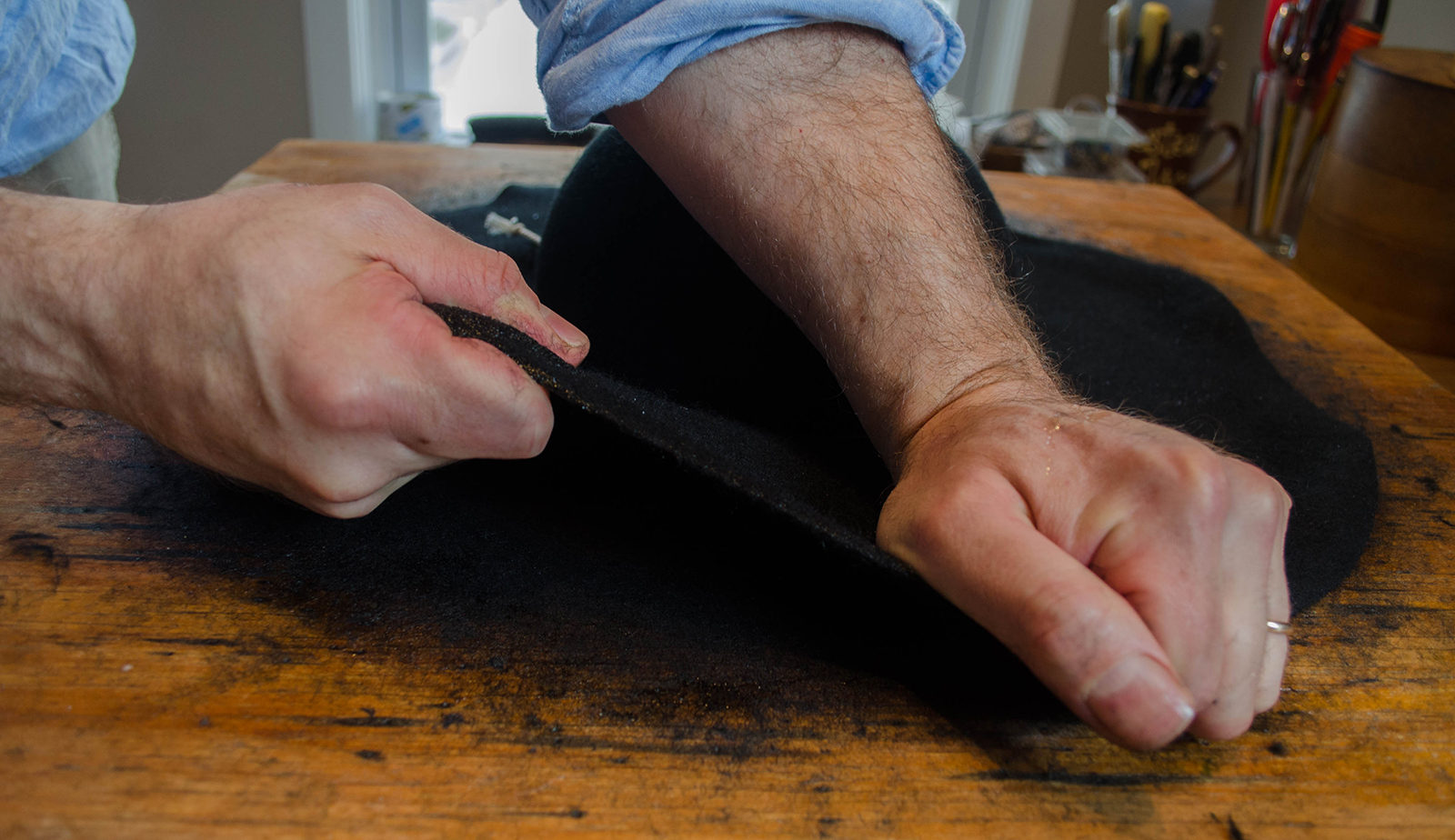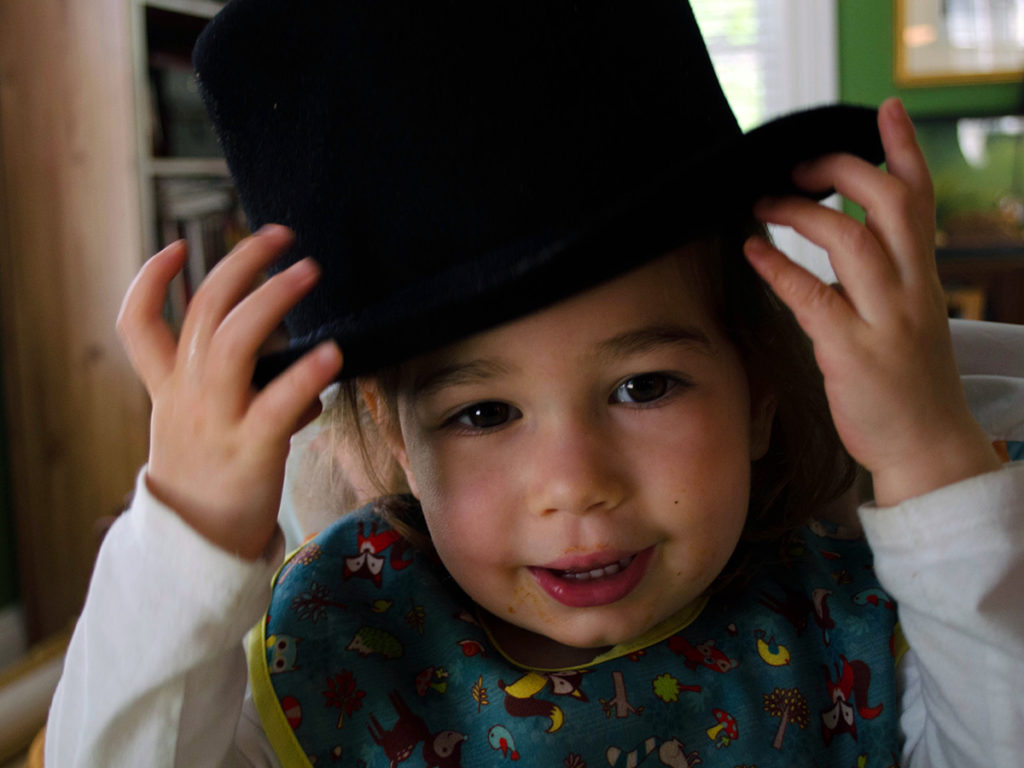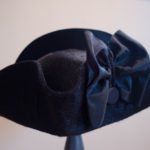Inside an upper-middle class home in the suburbs of Somerville, Massachusetts, a man works to create a mirror into the past. The small living room features three shelves, where titles like The American-Built Clipper Ship share space with an encyclopedia of 18th-century fashion. From their frames on the wall, men wearing embroidered Nevernois hats and women dressed in elegantly pleated polonaise gowns watch as Matthew Brenckle, a full-time hatter, works busily but gently, sewing delicate, golden French lace. Brenckle possesses only a few rolls of the lace, and when the last piece is used, it can’t be bought on eBay or Etsy — a reality of business when one’s trade relies on making old hats that went out of fashion two centuries ago.
“Not old, just authentic [replicas],” says Brenckle, whose attention to detail remains paramount to his occupation. He is fussy about even the thread he uses to sew the lace and accoutrements (buttons, gold trim, rosettes made from taffeta) onto the hat. In return, Brenckle earns the satisfaction of knowing his labor contributes to an accurate retelling of the past, an interest that began as a young man. Brenckle graduated from Brown University with a degree in history, and later worked as a curator at the USS Constitution Museum in Charlestown, Massachusetts. While his area of academic expertise is maritime history, his passion lies in a different kind of storytelling, one where specifics count. “What are stories without details?” he asks, as his gray-blue eyes scrunch in concentration while he tackles a stubborn knot in his thread. “I have been doing this for 23 years, and even as a kid, I knew that it would be a disservice to history if my details were not in place.”

Brenckle’s father was an archaeologist who often allowed his son to accompany him on excavations and digs. As a man, his digs for history involve fabrics and notions, not dirt — but both share a similar passion for the past. For the younger Brenckle, that passion is seen in the tentative curl of his lip as he executes the first steps of preparing the wool, and in the studied concentration as he pores over a thick volume on colonial British fashion to design a particular rosette on the hat.
That exacting authenticity and his occupational joy may explain his success and reputation in the re-enactment community. After 11 years, customers refer to him as a master hatter, a phrase formerly used to describe accomplished creators, but which has long since moved out of usage due to the endangered species that is people who create head pieces. “He is so busy all the time,” says Stephen Hathcock, one of Brenckle’s dedicated customers. “The kind of work he puts into each one of his pieces is intense. You can buy cheap hats for a dollar on the internet. But once you see something that he makes, you can’t go back to inauthentic, tacky stuff.”
Brenckle, who is always working on two or three hats at a time, has received orders from countries ranging from England and France to Australia, and Canada. His creations cost anywhere from $165 to $250. He completes three to four each week, using materials as close to authentic as possible so that his clients enjoy a richer re-enactment experience.

For Brenckle, that fascination with all things historical extends beyond his hats and into his actual, 21st-century life‚ one that also involves a wife and daughter, who support his historical interests. He describes himself as “a full-time dad and a part-time civilian from the late 18th century.” His surroundings reflect that split identity. Scraps of felt and lace share the floor with a copy of Becoming Americans, a scarlet pincushion, a green crayon, a multi-colored rattle, and a half-finished wallet that his wife, Victoria, a fellow re-enactor, is making for him. “We met at a re-enactment,” Victoria says. “And honestly, that is one of the reasons we started dating.” A fifth-grade teacher, she uses her background in re-enactments to teach her students about the Revolution and other important historical events.
But both she and her husband are more fascinated by the lives people led than the battles they fought. “Re-enacting history is educational, fun, and involves a lot of research,” Brenckle adds. “But re-enactment is not the same as reliving. We cannot relive the past, nor do I think it is desirable. If you think of even luxurious mansions from the 18th century, by today’s standards, that was like going camping,” he adds as he threads an old button to put on one of the hats he’s making for a re-enactment at Fort Ticonderoga. “No central heating, disease epidemics. Reliving history would involve living with those things as well, which is just not possible. To glorify [the past] needlessly is to alter the authenticity of its actual story.”

For Brenckle, the genuineness of re-enactment is more important than being in character all the time. Even as a hatter, he recognizes that his method of replicating the hats is modern and aided by tools not present in the 18th century. An average cocked hat from the Revolutionary War was made from coarse wool harvested from the coats of locally raised sheep. Today, most wool comes from Merino sheep, a hybrid breed that makes wool production more economical, and which did not exist two centuries ago. Similarly, the use of modern implements, like steam irons and a gas stove, have made hat making a much shorter process than it used to be.
It takes Brenckle about an hour to prepare the felt for setting the hat and another two hours to add the lace and frill that some designs require. While he has been making hats since the age of 14, it was only in 2007 that he left his job at the museum to do it full time. “And now that I have a daughter, I’m able to use the extra time to dote on her completely,” he says as he places an early 19th-century style top hat on her head. Georgiana Brenckle is only 2 years old, but she’s attended re-enactments with her parents in full 18th-century regalia since she was an infant. At each of these events, the re-enactors enjoy holding her. One time, she was so popular that it took an hour for her to return to her mother’s lap. For Brenckle and Victoria, having their child — dressed in a museum-quality frilly smock and spotted kerchief — be so welcomed represents the culture of the re-enactment community and its importance to them.
That culture extends into the Brenckle’s kitchen, where pages from an old, frayed recipe book, assembled with photocopies, prints, and handwritten pages, sits on a countertop and boasts a wealth of culinary knowledge from the 18th century. Victoria enjoys making dishes that have long since disappeared from menus and contemporary plates. “Her meat pies are really good,” Brenckle says with relish. “It is fresh meat pounded flat and then rolled out in French pastry. Delicious!” He also enjoys dismissing the notion that the culinary repertoire from the colonial time period consisted of fire cakes and one-pot meals.

Those meat pies also demonstrate the difference in a civilian reenactment from a military one. “There’s more to every war,” he says. “Between any two wars, there is peacetime in which people live each day, doing different things to break the monotony. That is certainly more exciting than simply pretending to shoot pretend-soldiers when there is no way to be authentic about the fear and reality of death that is a basic, undeniable fact of war.”
He stops mid-sentence. A present-day need voiced from the high chair interrupts his civilian soliloquy. Georgiana finished her breakfast, and it is time for her father to give her the watermelon that waits for her in the fridge. After he brings her the crimson cubes, Georgiana happily munches on the fruit. In between bites, her father wipes her juice-smeared face with a napkin. Just beyond them, in the living room, a cocked hat for the Languedoc Regiment sits unfinished on a settee, with a piece of French lace dangling from its edge.
Cover photo credit: Ankur Dang.



